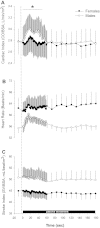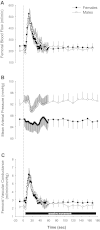Passive limb movement: evidence of mechanoreflex sex specificity
- PMID: 23086995
- PMCID: PMC3543682
- DOI: 10.1152/ajpheart.00532.2012
Passive limb movement: evidence of mechanoreflex sex specificity
Abstract
Previous studies have determined that premenopausal women exhibit an attenuated metaboreflex; however, little is known about sex specificity of the mechanoreflex. Thus, we sought to determine if sex differences exist in the central and peripheral hemodynamic responses to passive limb movement. Second-by-second measurements of heart rate, stroke volume, cardiac output (CO), mean arterial pressure, and femoral artery blood flow (FBF) were recorded during 3 min of supine passive knee extension in 24 young healthy subjects (12 women and 12 men). Normalization of CO and stroke volume to body surface area, expressed as cardiac index and stroke index, eliminated differences in baseline central hemodynamics, whereas, peripherally, basal FBF and femoral vascular conductance were similar between the sexes. In response to passive limb movement, women displayed significantly attenuated peak central hemodynamic responses compared with men (heart rate: 9.0 ± 1 vs. 14.8 ± 2% change, stroke index: 4.5 ± 0.6 vs. 7.8 ± 1.2% change, cardiac index: 9.6 ± 1 vs. 17.2 ± 2% change, all P < 0.05), whereas movement induced similar increases in peak FBF (167 ± 32 vs. 193 ± 17% change) and femoral vascular conductance (172 ± 31 vs. 203 ± 16% change) in both sexes (women vs. men, respectively). Additionally, there was a significant positive relationship between individual peak FBF and peak CO response to passive movement in men but not in women. Thus, although both sexes exhibited similar movement-induced hyperemia and peripheral vasodilatory function, the central hemodynamic response was blunted in women, implying an attenuated mechanoreflex. Therefore, this study reveals that, as already recognized with the metaboreflex, there is likely a sex-specific attenuation of the mechanoreflex in women.
Figures




Similar articles
-
The Mechanoreflex and Hemodynamic Response to Passive Leg Movement in Heart Failure.Med Sci Sports Exerc. 2016 Mar;48(3):368-76. doi: 10.1249/MSS.0000000000000782. Med Sci Sports Exerc. 2016. PMID: 26418560 Free PMC article.
-
Mechanistic insights into the modulatory role of the mechanoreflex on central hemodynamics using passive leg movement in humans.J Appl Physiol (1985). 2018 Aug 1;125(2):545-552. doi: 10.1152/japplphysiol.01085.2017. Epub 2018 May 17. J Appl Physiol (1985). 2018. PMID: 29771607 Free PMC article.
-
Perfusion pressure and movement-induced hyperemia: evidence of limited vascular function and vasodilatory reserve with age.Am J Physiol Heart Circ Physiol. 2013 Feb 15;304(4):H610-9. doi: 10.1152/ajpheart.00656.2012. Epub 2012 Dec 21. Am J Physiol Heart Circ Physiol. 2013. PMID: 23262136 Free PMC article.
-
Baroreflex and neurovascular responses to skeletal muscle mechanoreflex activation in humans: an exercise in integrative physiology.Am J Physiol Regul Integr Comp Physiol. 2017 Dec 1;313(6):R654-R659. doi: 10.1152/ajpregu.00242.2017. Epub 2017 Aug 30. Am J Physiol Regul Integr Comp Physiol. 2017. PMID: 28855178 Free PMC article. Review.
-
Physiological Impact and Clinical Relevance of Passive Exercise/Movement.Sports Med. 2019 Sep;49(9):1365-1381. doi: 10.1007/s40279-019-01146-1. Sports Med. 2019. PMID: 31264182 Free PMC article. Review.
Cited by
-
Ventilation Increases with Lower Extremity Venous Occlusion in Young Adults.Med Sci Sports Exerc. 2016 Mar;48(3):377-83. doi: 10.1249/MSS.0000000000000797. Med Sci Sports Exerc. 2016. PMID: 26484951 Free PMC article. Clinical Trial.
-
Gene and protein expression of dorsal root ganglion sensory receptors in normotensive and hypertensive male rats.Am J Physiol Regul Integr Comp Physiol. 2022 Aug 1;323(2):R221-R226. doi: 10.1152/ajpregu.00007.2022. Epub 2022 May 24. Am J Physiol Regul Integr Comp Physiol. 2022. PMID: 35608265 Free PMC article.
-
Concurrent metaboreflex activation increases chronotropic and ventilatory responses to passive leg movement without sex-related differences.Eur J Appl Physiol. 2023 Aug;123(8):1751-1762. doi: 10.1007/s00421-023-05186-4. Epub 2023 Apr 4. Eur J Appl Physiol. 2023. PMID: 37014452 Free PMC article.
-
Peripheral Mechanisms of Ischemic Myalgia.Front Cell Neurosci. 2017 Dec 22;11:419. doi: 10.3389/fncel.2017.00419. eCollection 2017. Front Cell Neurosci. 2017. PMID: 29311839 Free PMC article. Review.
-
Whole-body vibration training in obese subjects: A systematic review.PLoS One. 2018 Sep 5;13(9):e0202866. doi: 10.1371/journal.pone.0202866. eCollection 2018. PLoS One. 2018. PMID: 30183742 Free PMC article.
References
-
- Azabji Kenfack M, Lador F, Licker M, Moia C, Tam E, Capelli C, Morel D, Ferretti G. Cardiac output by Modelflow method from intra-arterial and fingertip pulse pressure profiles. Clin Sci (Lond) 106: 365–369, 2004 - PubMed
-
- Baum K, Selle K, Leyk D, Essfeld D. Comparison of blood pressure and heart rate responses to isometric exercise and passive muscle stretch in humans. Eur J Appl Physiol 70: 240–245, 1995 - PubMed
-
- Bogert LW, van Lieshout JJ. Non-invasive pulsatile arterial pressure and stroke volume changes from the human finger. Exp Physiol 90: 437–446, 2005 - PubMed
-
- Celermajer D, Sorensen K, Spiegelhalter D, Georgakopoulos D, Robinson J, Deanfield J. Aging is associated with endothelial dysfunction in healthy men years before the age-related decline in women. J Am Coll Cardiol 24: 471, 1994 - PubMed
Publication types
MeSH terms
Grants and funding
LinkOut - more resources
Full Text Sources
Other Literature Sources

